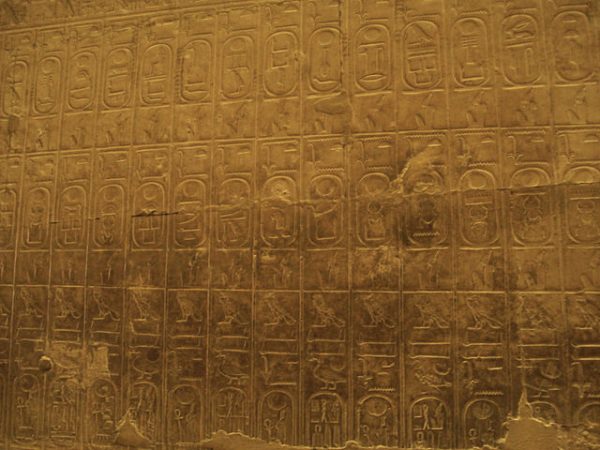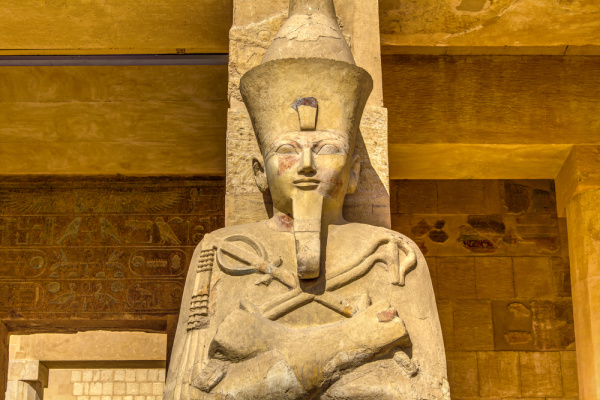A dynastic timeline of Ancient Egypt
A dynastic timeline of Ancient Egypt
A dynastic timeline of Ancient Egypt
-
Hannah
-
Hannah

Ramesses II, Luxor Temple
It was around 5000 BC that the first settlers made homes in Egypt – nomadic tribes who created settlements in the Nile Valley to take advantage of this source of water, the only one for many miles. Fast-forward 2,000 years and you reach the dawn of the pharaonic period of history, which would endure for some 3,000 years.
Three thousand years is a long span of history to try to comprehend, and naturally we look to organise it chronologically. The Ancient Egyptians haven’t made that easy for us, though; rather than maintaining a chronological timeline, they would date according to the reign of the pharaoh – so, for example, an inscription may date an artefact to year 2 of Ramesses II.
Creating an exact timeline of the rulers of Egypt is impossible; the clarity of information simply doesn’t exist. But we have a pretty good idea of the order in which pharaohs ruled, and some idea of when.
Our knowledge has been collated from various sources. Particularly useful was the discovery of the King List at Abydos, an ancient city located in Upper Egypt. Here are inscribed the cartouches of 76 kings, from Menes, founder of the 1st Dynasty, to Ramesses I, father of Seti I. The list is incomplete, but is in a chronological arrangement.

The Abydos King List
The Turin Royal Canon is similarly invaluable, being the most complete list ever found of the kings of Ancient Egypt.
Another excellent source of knowledge is the work of Manetho, which was referenced by later scholars. Manetho was an Egyptian priest and scholar from the third century BC who decided to document the history of his country. It was he who devised the dynastic system that we use to this day, dividing up the timeline into 31 dynasties. Today, we group these dynasties into three core kingdoms, with ‘intermediate’ periods between them.
Historians quibble over dates (and will surely never find agreement), so here I take my dates from one source: Chronicle of the Pharaohs by Egyptologist and archaeologist Peter A. Clayton.
Early Dynastic Period
Dynasties Zero to Two, c. 3150–2686 BC
The history of the pharaonic period begins with the reign of Narmer in around 3100 BC. Victorious in battle, he unified Lower and Upper Egypt to become ‘the king of the Two Lands’. Now, a king could only be a true pharaoh if he ruled both lands, and in recognition of this, the title ‘He of the two ladies’ was bestowed on him at his coronation (‘ladies’ refers to the cobra goddess of Lower Egypt and the vulture goddess of Upper Egypt).
Old Kingdom
3rd to 6th dynasties, c. 2686–2181 BC
Egypt was flourishing, and the pharaoh – the living embodiment of the god Horus – truly was king. This period saw the construction of enduring monuments, notably the Step Pyramid of Djoser and the Pyramids and Sphinx at Giza. The Pyramid Texts were created during this era, laying down the death rituals for which the Ancient Egyptians are so famous (see my article ‘Guiding the dead: Ancient Egyptian funerary texts’).

The Pyramids and the Sphinx at Giza
First Intermediate Period
7th to 10th dynasties, c. 2181–2040 BC
A historical hiccup occurred at this point: the influence of the pharaoh waned in the face of political upheaval. Two power bases existed, one in Lower Egypt and one in Upper Egypt, and a struggle ensued, leaving Egypt in chaos.
Middle Kingdom
11th and 12th dynasties, c. 2040–1782 BC
The pharaoh Mentuhotep II reunified Egypt and ushered in a new era of growth and prosperity, a ‘golden age’. Notable pharaohs from this period include the battle-thirsty warrior Senusret III, and Amenemhet III, who reached new heights in exploiting Egypt’s natural resources to build riches. This period also saw the first female pharaoh, Sobekneferu.
Second Intermediate Period
13th to 17th dynasties, c. 1782–1570 BC
Sobekneferu died with no heirs, which left the job of pharaoh open. Once again, unification fell apart. The 15th dynasty was founded by Salitis, whose heritage was the Hyksos people of West Asia. The Hyksos were eventually expelled from the country by Ahmose I, who once again brought the country together and reigned as the first pharaoh of the 18th Dynasty.
New Kingdom
18th to 20th dynasties, c. 1570–1070 BC
The New Kingdom put Egypt on the map internationally through its military campaigns, trading and wealth. Now we come to names I am sure you will know, including Hatshepsut, the famous female king; Thutmose III, who carved out for Egypt its greatest ever empire; Akhenaten and his wife Nefertiti, who attempted to introduce a monotheistic religion (one god only); and Ramesses II, the ‘Great Ancestor’, a most celebrated and popular king.

The pharaoh Hatshepsut
Third Intermediate Period
21st to 26th dynasties, c. 1080–525 BC
War, displaced peoples, famine, power-hungry priests – these, and many more factors, contributed to another run of years without a strong, centralised, Egyptian pharaoh in power. After the glorious centuries of the New Kingdom, this was quite the fall from grace.
Late Period
27th to 30th dynasties, c. 525–332 BC
In this period ruled the last of the native Egyptian pharaohs: Nectanebo II. Keeping Egypt unified under an Egyptian king was a losing battle: the Persians kept taking control – until, in 332, Alexander the Great, a Macedonian Greek, marched into Egypt and pushed out the Persians.
Graeco-Roman Period
332–30 BC
After Alexander’s death in 323, his friend and general Ptolemy I Soter took control of Egypt, thus bringing Egypt into the Ptolemaic Kingdom. In a bid to win over the population, the rulers of the Ptolemaic dynasty adopted Egyptian traditions and declared themselves pharaohs. The last dynasty ended with the death of Cleopatra VII and the annexation of Egypt by the Roman Empire. It truly was the end of an era.
Photo credits: 1) Alberto Loyo/Shutterstock.com; 2) isawnyu/Wikipedia; 3) AlexAnton/Shutterstock.com; 4) mareandmare/Shutterstock.com.